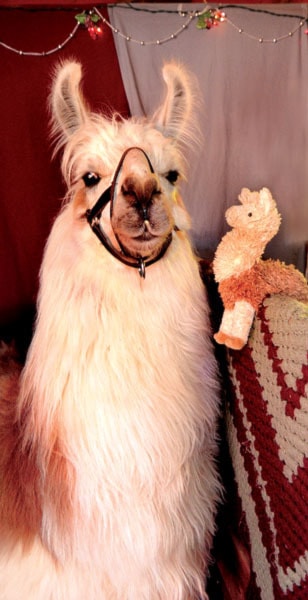With big brown eyes and eyelashes to die for, they’re hard to resist.
But looks aren’t the only reason so many people are drawn to the beautiful animals that are alpacas and llamas.
Craig Bacon, convenor of the alpaca and llama division at the Salmon Arm Fall Fair, knows alpacas well. His family has been raising them as a livestock business, Tocino Alpacas, for the past eight years and says they’re gentle and easy to look after. They’re also easy on pastures because they don’t have hooves, only pads like dogs. They’re also grazers, taking the top off the grass without pulling it up by the roots. One particular bonus, says Bacon – “They have communal poop piles so it makes clean-up really easy.”
And their manure makes great fertilizer, he adds.
But do they spit? That’s the question alpaca and llama owners are most often asked.
“They can all spit, but most of them hardly ever spit. If they spit, it’s if they’re stressed or else if they’re competing over the same piece of food,” Bacon said, adding it’s unfortunate that spitting is what comes to mind for many people when they think of the animals.
“I’ve had mine for eight years and they have never spit in my direction once.”
One important detail in raising alpacas and llamas is having good fencing, he says. Not to keep the alpacas in, but to keep predators like dogs and coyotes out.
Alpacas and llamas have a built-in alarm system. When one sees a predator, it will make what Bacon describes as “a shrieking alarm sound.” It alerts the herd and they all bunch together. Mother alpacas and llamas, meanwhile, are doting parents.
“If the baby walks one metre, the mother will follow it.”
Normally, rather than shrieking, the animals communicate with each other via a sort of humming sound.
About 50 animals from 15 different farms came to the fall fair, mostly alpacas and about five llamas. Including Tocino Alpacas, one other alpaca and one llama operation from Salmon Arm attended. As well as the Okanagan-Shuswap, owners came from Pemberton, Grand Forks, Langley and 100 Mile House.
Alpacas are smaller and are raised for their fine fibre, Bacon says. Llamas, which are larger, are raised for their fibre and also as “guardian animals.”
“You’ll often see them with a flock of sheep, some people put them with cattle. They’re quite territorial, they keep predators away like coyotes.”
Kagen Stephenson of Sicamous’ Willow Mist Farm has 14 llamas on her acreage on Cambie Solsqua Road, down from her previous number of 24.
She says “they’re just lovely animals,” noting how intelligent and easy to keep they are. She hopes to train one to pull a buggy to accommodate a child who is allergic to horses.
Because llamas are only sheared once every two years, if they’re sheared at all, the ones at the fair look haughtily distinguished with their regal stance and long flowing coats.
Tocino Alpacas breeds and sells alpacas, and creates clothing and products out of their fibre. Bacon says there are three categories of alpacas and llamas — those who people want as pets, those for the commercial or fibre industry and, at the high-end, quality breeding stock.
The gestation period for llamas and alpacas is 11-and-a-half months, and they generally have only one baby at a time, so the birth of a baby is quite an occasion. Bacon says they’re generally easy birthers and don’t need assistance.
Alpacas being used for fibre are sheared in the spring, he says, which prevents them from getting heat stroke in the summer, but also allows them to have an adequate coat grown back for winter.
Alpacas and llamas have more colour variety than any other fibre-producing animal. Bacon’s operation raises mainly white animals, though, because white fibre is easier to dye.
At the fair’s alpaca show, animals were divided into classes based on age, sex and colour. But it isn’t enough to simply look pretty. When they’re judged, 60 per cent of the mark goes to fleece and 40 per cent to conformation of the animal. Owners bring bags of the animal’s fleece for the judge to peruse.
So how much are llamas and alpacas worth? They can sell for as little as $250 for a pet quality animal and as much as $10,000 for a good breeding female.
However, that’s not the uppermost limit. Bacon notes that he heard last year of an auction in the United Sates where a breeding male went for no less than $675,000.
